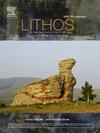Identification of fractionation processes in the Himalayan leucogranites-Case study from the Nyalam region
IF 2.9
2区 地球科学
Q2 GEOCHEMISTRY & GEOPHYSICS
引用次数: 0
Abstract
As the product of a collisional belt, Himalayan leucogranites provide insights into the geodynamic and thermal evolution of tectonically thickened crust. Nevertheless, the petrogenesis of these leucogranites is still a much-debated topic. They are typically interpreted as the primary melt formed by partial melting of the Greater Himalayan Crystalline Complex (GHC). There is, however, another view that they are the products of fractional crystallization of less evolved parent magmas. This study aims to explore these competing petrogenetic models. We collected biotite granite, two-mica granite, tourmaline granite, and garnet granite in the Nyalam region for mineralogical and geochemical studies. The granites occur as small laccoliths, sills, and dikes in the upper GHC and the South Tibet Detachment System (STDS). The plagioclase in biotite granite is oligoclase and andesine (An >20) but is more sodic (An <20) in other rocks. From biotite granite to two-mica granite to tourmaline granite, Mg and Ti in biotite and Zr/Hf in zircon gradually decrease, and AlVI and XFe in biotite and Hf in zircon increase correspondingly. Garnet is typically euhedral and spessartine-rich (spessartine >30 wt%), and it only appears in garnet granite, suggesting an increase of Mn/(Fe + Mg) in the melt. These variations suggest that biotite granite is the least evolved rock, and that two-mica granite, tourmaline granite, and garnet granite are increasingly fractionated. This fractionation trend is supported by trace element compositions. Rb-Sr-Ba trace element modeling suggests that the feldspars (plagioclase and k-feldspar) are the main fractionated minerals. Zr![]() Hf modeling indicates that the decrease of Zr/Hf ratio in the melt is related to the fraction of zircon fractionated, which is controlled by the change of temperature and melt composition. Additionally, very high Rb/Sr (>20), low Zr/Hf (<20), and strongly negative Eu anomaly (0.2) in garnet granite strongly suggest that the melt experienced extensive fractionation. Compiled Himalayan leucogranite geochemistry presents a similar pattern to our data and modeling result, suggesting that the variety of Himalayan leucogranites might relate to fractional crystallization. In addition, the composition of leucogranites in the Nyalam is a function of spatial position and age. The leucogranites that were produced during the activity of STDS and developed close to STDS have more evolved compositions, indicating that the development of STDS might have played an essential role in the differentiation of leucogranite in the Himalaya.
Hf modeling indicates that the decrease of Zr/Hf ratio in the melt is related to the fraction of zircon fractionated, which is controlled by the change of temperature and melt composition. Additionally, very high Rb/Sr (>20), low Zr/Hf (<20), and strongly negative Eu anomaly (0.2) in garnet granite strongly suggest that the melt experienced extensive fractionation. Compiled Himalayan leucogranite geochemistry presents a similar pattern to our data and modeling result, suggesting that the variety of Himalayan leucogranites might relate to fractional crystallization. In addition, the composition of leucogranites in the Nyalam is a function of spatial position and age. The leucogranites that were produced during the activity of STDS and developed close to STDS have more evolved compositions, indicating that the development of STDS might have played an essential role in the differentiation of leucogranite in the Himalaya.
喜马拉雅白花岗岩体分选过程的识别——以聂拉木地区为例
作为碰撞带的产物,喜马拉雅白花岗岩提供了构造增厚地壳的地球动力学和热演化的见解。然而,这些浅花岗岩的岩石成因仍然是一个有争议的话题。它们通常被解释为大喜马拉雅结晶复合体(GHC)部分熔融形成的初级熔体。然而,还有另一种观点认为,它们是演化程度较低的母岩浆分馏结晶的产物。本研究旨在探索这些相互竞争的岩石成因模式。我们采集了聂拉木地区的黑云母花岗岩、二云母花岗岩、电气石花岗岩和石榴石花岗岩进行矿物学和地球化学研究。花岗岩在GHC上部和藏南滑脱系(STDS)中以小的青石、岩壁和岩脉的形式赋存。黑云母花岗岩中的斜长石为低长石和安长石(An <20),而其他岩石中的斜长石多为钠长石(An <20)。从黑云母花岗岩到二云母花岗岩再到电气石花岗岩,黑云母中的Mg、Ti和锆石中的Zr/Hf逐渐降低,黑云母中的AlVI、XFe和锆石中的Hf相应升高。石榴石为典型的自面体,富含辉绿石(辉绿石>;30 wt%),且只出现在石榴石花岗岩中,表明熔体中Mn/(Fe + Mg)增加。这些变化表明,黑云母花岗岩是演化最少的岩石,而二云母花岗岩、电气石花岗岩和石榴石花岗岩的分异程度越来越高。这种分馏趋势得到了微量元素组成的支持。Rb-Sr-Ba微量元素模拟表明,长石(斜长石和钾长石)是主要分选矿物。ZrHf模拟结果表明,熔体中Zr/Hf比值的降低与分馏锆石分数有关,分馏分数受温度和熔体成分变化的控制。石榴石花岗岩中Rb/Sr (>20)偏高,Zr/Hf (<20)偏低,Eu负异常(0.2)强烈提示熔体发生了广泛分馏。整理的喜马拉雅白花岗岩体地球化学模式与我们的数据和模拟结果相似,表明喜马拉雅白花岗岩体的多样性可能与分馏结晶有关。此外,聂拉木浅花岗岩的组成是空间位置和年龄的函数。在性传播疾病活动期间产生并接近性传播疾病发育的浅花岗岩,其成分更为演化,表明性传播疾病的发育可能在喜马拉雅浅花岗岩的分异过程中发挥了重要作用。
本文章由计算机程序翻译,如有差异,请以英文原文为准。
求助全文
约1分钟内获得全文
求助全文
来源期刊

Lithos
地学-地球化学与地球物理
CiteScore
6.80
自引率
11.40%
发文量
286
审稿时长
3.5 months
期刊介绍:
Lithos publishes original research papers on the petrology, geochemistry and petrogenesis of igneous and metamorphic rocks. Papers on mineralogy/mineral physics related to petrology and petrogenetic problems are also welcomed.
 求助内容:
求助内容: 应助结果提醒方式:
应助结果提醒方式:


